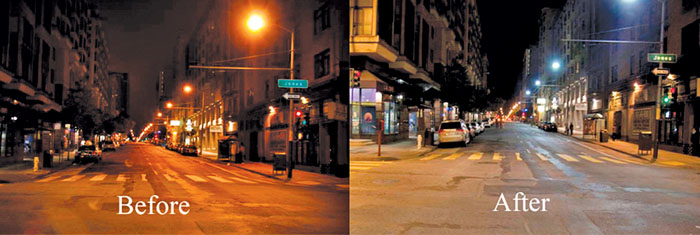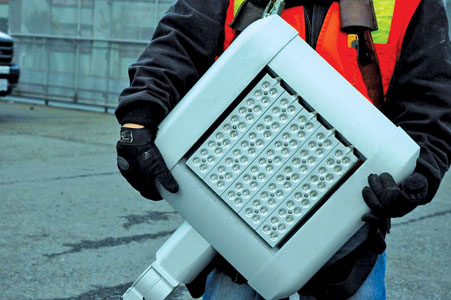The San Francisco Public Utility Commission (SFPUC) recently announced announced plans to replace thousands of the inefficient, high-pressure sodium cobra-head style streetlights that dot the City—the ones that emit the orange glow—with new, state-of-the-art LED fixtures later in 2013.

The San Francisco Public Utilities Commission will be replacing 18,500 of the City’s outdated high-pressure sodium streetlights with state-of-the-art LED fixtures that consume 50% less electricity.
By Bill Picture
Published: January, 2013
The San Francisco Public Utility Commission (SFPUC) recently announced announced plans to replace thousands of the inefficient, high-pressure sodium cobra-head style streetlights that dot the City—the ones that emit the orange glow—with new, state-of-the-art LED fixtures later in 2013.
At first glance, the aptly dubbed "LED Street Light Conversion Project" might appear one of the City’s more mundane green endeavors. But a closer examination reveals some exciting details: better, more-efficient lighting and the creation of hundreds of new job opportunities for Bay Area small businesses, not to mention some sleek pole-top doo-dads that any designer is sure to find sexy—for a streetlight, that is.
Only a matter of time
Household light bulbs, flashlights, even Christmas lights: ultra-efficient LED versions of all of these items began appearing on store shelves a few years ago, so it was only a matter of time before LED technology began being used to illuminate much larger areas.
"LED technology has been around for a while, but it had to be adapted for this specific use, and that takes a while to get just right," said SFPUC spokesperson Charles Sheehan. "Cost was also a factor.We had to wait for it to become affordable, otherwise it didn’t make sense."
The ultra-efficient new streetlights will consume about 50 percent less electricity than their predecessors, saving San Francisco a lot of money in the long term by significantly reducing its electricity bill. But upfront costs are steep, to which any homeowner or business owner who has made the switch to LED can attest.
"LED light bulbs are one of the most expensive types of light bulbs on the market," said Jay Leone of eHow.com. Leone said LED products are difficult to produce, and therefore very expensive. "And the production costs associated with LEDs is passed on to the consumer in the form of a high price tag."
SFPUC maintains about 25,000 streetlights, which is 60 percent of all of the streetlights in the City. (PG&E owns and maintains the other 40 percent.) Of the 25,000, 18,500 will be getting the LED facelift, so you can see why cost is a factor. The balance of the SFPUC’s streetlights sport different style heads and will be upgraded at a later date, when the LED technology is adapted to suit those models.
In addition to the energy savings, helping further offset the cost of the new fixtures is the fact that the LED fixtures will only need to be replaced every 15 to 20 years. The current fixtures typically burn out after only four years. That means less money spent maintaining the streetlights.
Like a full moon every night
When the 14-month-long project is completed, what drivers, bicyclist and pedestrians alike can expect to notice right away is that nighttime lighting conditions on city streets will be dramatically improved. Instead of the strange orange glow given off by traditional high-pressure sodium streetlight fixtures (what you see from airplane windows at night), the light from the LED fixtures will be more similar to the natural white light of the moon.
"The quality of light will definitely be improved," Sheehan said. Still, Sheehan was reluctant to say that the new LED streetlights will provide more light. "There are a lot of factors that can determine the actual amount of light in a given area, for instance, how close together street lights are placed, and that varies in different parts of the city."
The new fixtures will feature "smart controllers" that allow the City to receive real-time information from each street light, remotely monitor each light’s performance, adjust light intensity as needed, and know when a light is out or about to die.
The process of replacing an old fixture with a new one is a very simple one, taking only about 30 minutes and leaving the existing pole and street light arm untouched. But multiply those 30 minutes by 18,500 streetlights, and this is way more work than the SFPUC currently has the manpower to handle on its own. So, the replacement project will be farmed out to small businesses in the area, helping support the local economy.
It’s important to note that the project’s $16 million price tag will not be passed on to SFPUC customers, nor will the conversion have any impact on private property.
Sheehan expects the SFPUC to begin accepting bids from local businesses sometime in the spring or early summer. "Right now, we’re working on what the criteria and requirements will be that the bidders have to meet, such as the electrical standards," he explained.
As far as remaining ahead of the aforementioned green curve, San Franciscans will be happy to know that their beloved city remains close to the front. "A lot of cities are starting to move in this direction," Sheehan said, "but we’re still ahead of most of them."
All Photos courtesy of SFWATER.ORG

Once the 14-month-long, $16 million LED streetlight conversion project is completed, San Franciscans will notice dramatically improved nighttime lighting. LED output has been compared to the natural light of the moon.

Each fixture takes about 30 minutes to install, and the SFPUC will be farming the work out to local small businesses. Bids will begin being accepted in a few months.

